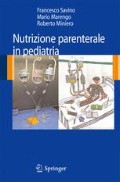Estratto
Il bambino malato, così come il bambino sano, deve essere alimentato in modo da soddisfare i suoi fabbisogni in termini di energia e nutrienti. La quantità e la qualità degli alimenti assunti influenzano la costituzione e le funzioni del suo organismo. Per una corretta alimentazione è necessario che l’assunzione di alimenti avvenga nel pieno rispetto delle funzioni dell’organismo e che non provochi squilibri eccessivi nell’omeostasi individuale. La determinazione qualitativa e quantitativa del supporto nutrizionale ha come punto di partenza l’identificazione dei fabbisogni del singolo soggetto in condizioni normali, e valuta le modificazioni necessarie per tenere conto delle particolari condizioni cliniche in grado di modificare la tolleranza ai vari substrati. Al fine di non incorrere in sovra o sottostime, il calcolo dei fabbisogni deve riferirsi al peso reale del paziente, considerando il peso ideale solo nei casi che si discostano nettamente dalla normalità.
Access this chapter
Tax calculation will be finalised at checkout
Purchases are for personal use only
Preview
Unable to display preview. Download preview PDF.
Bibliografia
World Health Organization (1985) Energy and protein requirements: report of a joint FAO/WHO/UNU expert consultation. Technical Report Series 724. WHO, Geneva
Società Italiana di Nutrizione Umana (1996) LARN — Livelli di assunzione raccomandati di energia e nutrienti per la popolazione italiana. Istituto Nazionale della Nutrizione, Roma
National Research Council (1989) Recommended dietary allowances, 10th ed. National Academy Press, Washington DC
Institute of Medicine. Food and Nutrition Board (2005) Dietary reference intakes. National Academy Press, Washington DC
Weels JCK, Cole TJ, Davies PSW (1996) Total energy expenditure and body composition in early infancy. Arch Dis Child 75:423–426
Fomon SJ (1993) Nutrition of normal infants. St Louis: Mosby-Year Book
ASPEN Board of Directors and the Clinical Guidelines Task Force (2002) Guidelines for the use of parenteral and enterai nutrition in adult and padiatric patients. JPEN 26(Suppl 1):52SA
National Advisory Group on Standards and Practice Guidelines for Parenteral Nutrition (1998) Safe practices for parenteral nutrition formulations. JPEN 22:49–66
ISTAT (1998) Indagine multiscopo sulle famiglie. Aspetti della vita quotidiana. Cultura socialità e tempo libero. Roma, 2000
Millward DJ, Fereday A, Gibson N et al (1997) Aging, protein requirements, and protein turnover. Am J Clin Nutr 66:774–786
Dupont C (2003) Protein requirements during the first year of life. Am J Clin Nutr 77:1544S–1549S
Koletzko B, Broekaert I, Demmelmair H et al for the EU Childhood Obesity Project (2005) Protein intake in the first year of life: a risk factor for later obesity? The E.U. childhood obesity project. Adv Exp Med Biol 569:69–79
Young VR, Borgonha S (2000) Nitrogen and amino acid requirements: the Massachusetts Institute of Technology amino acid requirement pattern. J Nutr 130:1841S–1849S
American Health Foundation (1994) Proceedings of the Children’s fiber conference. May 24th 1994, NY
American Academy of Pediatrics (1993) Carbohydrates and dietary fibre. In: American Academy of Pediatrics (ed) Pediatric Nutrition Handbook. 3a ed. AAD, Cominitee and Nutrition. ELK Grove Village
Butte NF (2000) Fat intake of children in relation to energy requirements. Am J Clin Nutr 72:1246S–1252S
Agostoni C, Riva E, Scaglioni S, Marangoni F, Radaelli G, Giovannini M (2000)Dietary fats and cholesterol in italian infants and children. Am J Clin Nutr 72:1384S–1391S
WHO (1990) Diet, nutrition and the prevention of chronic diseases. Technical report, series 797. Geneva WHO
Thorsdottir I, Gunnarsson BS (2006)Dietary quality and adequacy of micronutrient intakes in children. Proc Nutr Soc 65:366–375
Commission of the European Communities (1993) Nutrient and energy intakes for the European Community. Reports of the Scientific committee for food (31 series). Office for official publications of the European Communities, Luxembourg
Agostoni C, Decsi T, Fewtrell M et al ESPGHAN Committee on Nutrition (2008) Complementary feeding: a commentary by the ESPGHAN Committee on Nutrition. J Pediatr Gastroenterol Nutr 46:99–110
Ministero del Lavoro, della Salute e delle Politiche Sociali (2008) Linee guida nazionali per la promozione della salute orale e la prevenzione delle patologie orali in età evolutiva
Kerr MA, Livingstone B, Bates CJ et al (2009) Folate, related B vitamins, and homocysteine in childhood and adolescence: potential implications for disease risk in later life. Pediatrics 123:627–635
Author information
Authors and Affiliations
Rights and permissions
Copyright information
© 2009 Springer-Verlag Italia
About this chapter
Cite this chapter
Savino, F., Palumeri, E. (2009). Fabbisogni. In: Nutrizione parenterale in pediatria. Springer, Milano. https://doi.org/10.1007/978-88-470-1380-3_1
Download citation
DOI: https://doi.org/10.1007/978-88-470-1380-3_1
Publisher Name: Springer, Milano
Print ISBN: 978-88-470-1379-7
Online ISBN: 978-88-470-1380-3
eBook Packages: MedicineMedicine (R0)

